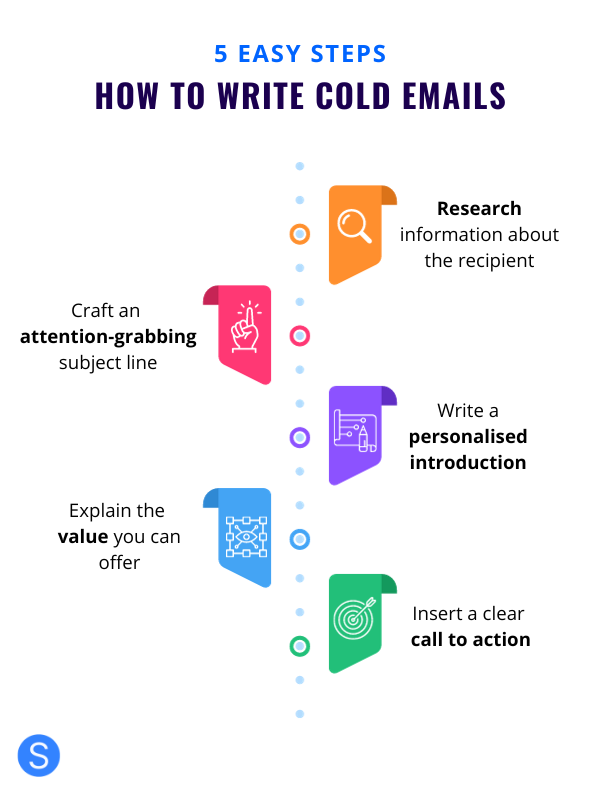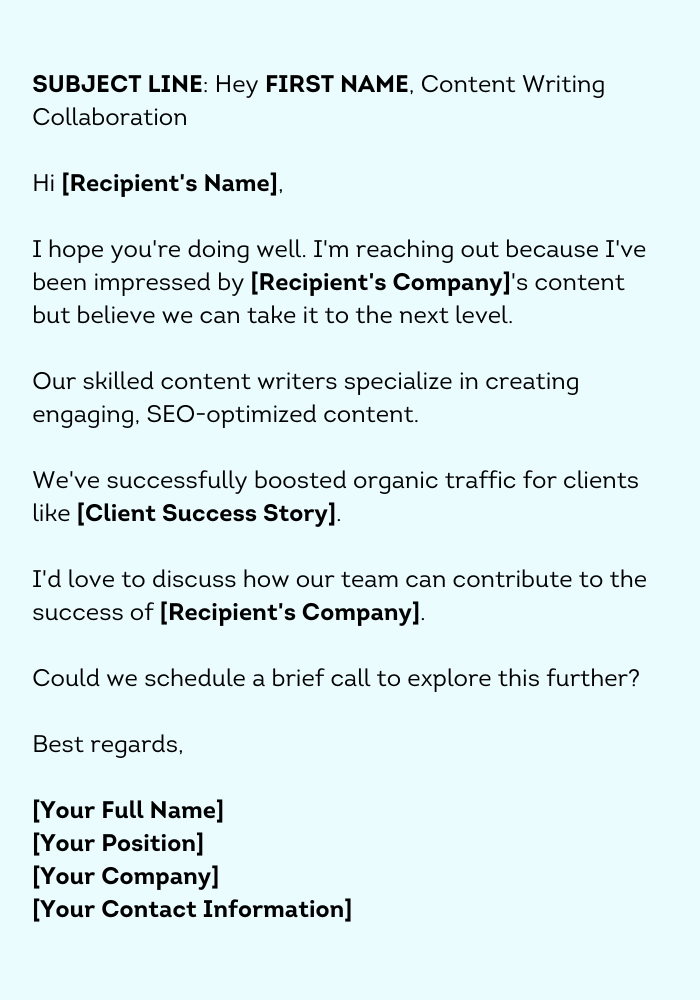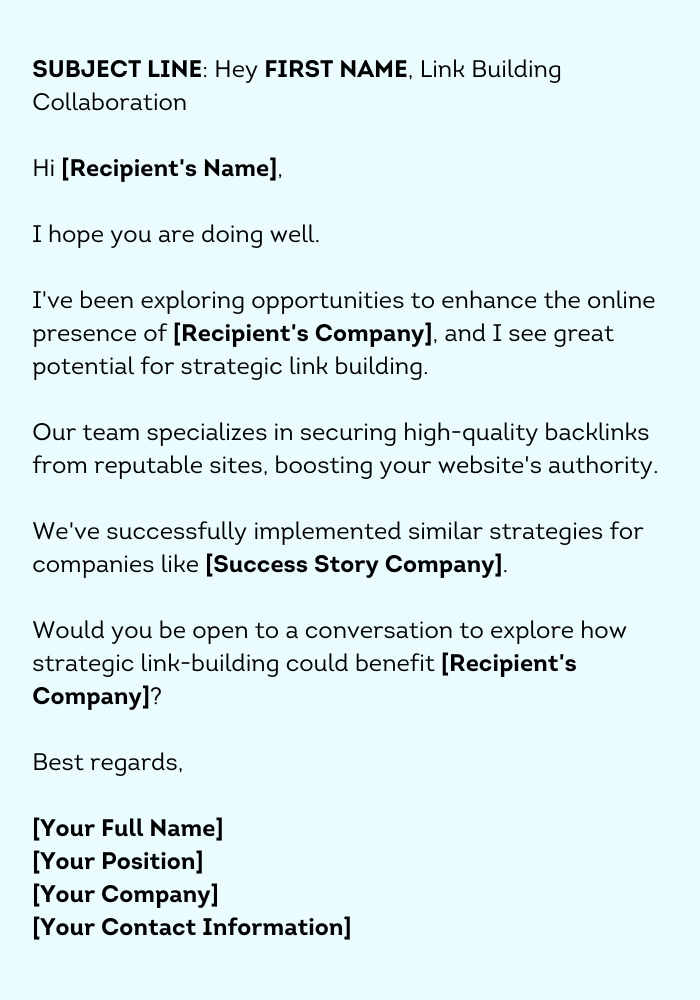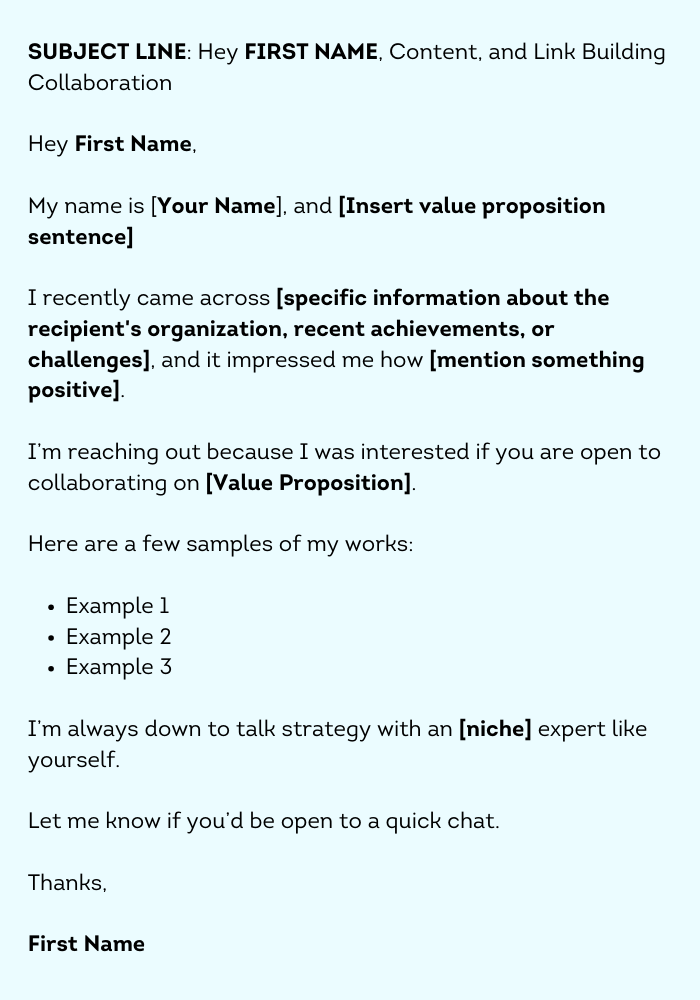Cold emailing can be highly effective. It’s a great way to build rapport and create relationships, but it can be challenging if not done correctly.
Many people fail at cold emailing because they:
- Don’t personalize their message, making it feel like spam.
- Fail to highlight the value they can provide to the recipient.
- Lack of a clear call to action.
How to write a cold email (that works) in 5 easy steps:
- Research
- Attention-grabbing subject line
- Personalized introduction
- Value proposition
- Clear call to action
Additionally, there are some mandatory dos and don’ts when writing cold emails.
Let’s dive right in!
What is Cold Emailing?
Cold emails are a great way to reach out to people you don’t know yet.
Unlike warm emails that you send to people you already have a connection with, cold emails require a bit more effort to grab their attention and get a positive response.
The main purpose of cold emails is to spark interest, initiate a conversation, and potentially create a mutually beneficial relationship or business opportunity.
They’re commonly used in various scenarios, such as sales, business development, networking, job applications, marketing, partnerships, investor outreach, event invitations, and even gathering product feedback.
To make your cold email effective, focus on personalization and relevance.
Research the recipient’s background, interests, and needs to tailor your email specifically to them. Show genuine interest by referencing their work, achievements, or past experiences and build rapport.
Another key element is providing value or offering a solution to a problem.
Highlight how your product, service, or expertise can benefit the recipient. Focus on their needs and emphasize the potential benefits rather than just promoting yourself or your company.
How to Write a Cold Email in 5 Easy Steps

Crafting a cold email that grabs the recipient’s attention and motivates them to respond positively requires careful writing.
Here are 5 simple steps to help you create the perfect cold email that no one can resist:
Research
Before crafting your cold email, spend 5 minutes researching the recipient.
Discover their background, interests, and any shared connections or experiences.
Look at their social media channels and websites to find out more about what they do.
This will help you create a personalized email and establish a genuine connection.
When you show that you’ve invested time in understanding their context, it demonstrates your genuine interest in them, and people appreciate that (a lot!)
Here is an example:
“I recently came across [specific information about the recipient’s organization, recent achievements, or challenges], and it impressed me how [mention something positive].
Given your leadership in [specific area], I believe there may be valuable opportunities to enhance your operational efficiency through customized software solutions.”
Attention-Grabbing Subject Line
The subject line is kind of the gateway to getting your email opened.
It’s the first thing the recipient sees, setting the tone and shaping their impression of your message and professionalism.
Think about it: In a crowded inbox, people often decide whether to open an email based on the subject line. If it doesn’t capture their interest, they might move on to the next message.
How to write a catchy subject line?
- Be concise and clear: Get straight to the point to grab attention quickly and convey the main idea or benefit.
- Create a Sense of Urgency: Use language that implies a limited time or opportunity to prompt immediate action.
- Personalize When Possible: Include the recipient’s name or refer to specific details to show that the email is tailored specifically for them.
Avoid generic subject lines and focus on something specific that would catch their attention.
Here are some examples of cold email subject lines:
“Hey, FIRST NAME, Content and Link Building Collaboration…”
“Hey, FIRST NAME, Great Article on TOPIC“
“Hey, First Name… Ranking for KEYWORD and SEO Chat”
Personalized Introduction
A personalized introduction is key to building relationships.
It shows that you see the recipient as an individual, not just a name on a list.
It also helps build rapport – when they see you’ve taken the time to tailor your message just for them, it demonstrates effort and genuine interest.
This makes them more likely to engage with your email.
How to write a personalized cold email introduction?
- Use the Recipient’s Name: Addressing the recipient by their name is a simple yet effective way to make the email feel more personal.
- Reference a Common Connection or Interest: If you share a mutual connection or have a common interest, mention it. This creates an immediate point of connection.
- Acknowledge Their Work or Achievements: Highlight something specific about the recipient’s work or accomplishments. This shows that you’ve taken the time to understand their background.
- Express Genuine Interest: Be clear about why you’re reaching out and express your curiosity about their perspectives or experiences. This conveys sincere interest and makes the conversation more engaging.
- Keep it Brief: Personalization doesn’t require a lengthy introduction. Keep it concise while making sure it’s meaningful and relevant.
Here is an example of a cold email introduction:
Hi [name], I am [x], and I run [site name] about [Y].
It’s impressive how much value [site] provides, especially on the topics of [x]- the way you broke down point A in [Y] article gave me a great idea for [Z].
Value Proposition
The value proposition communicates the specific benefits or solutions you offer.
A clear and compelling value proposition immediately captures the recipient’s attention because it answers the question, “What’s in it for me?” and encourages them to continue reading.
How to insert a value proposition?
- State your purpose: Clearly state the purpose of your email and the value you can offer to the recipient.
- Explain how you can help: Explain how your product, service, or idea can solve a problem or benefit their business.
Here is an example of well-crafted value proposition:
“I’d love to contribute with [x] if you’re interested. I did some research, and I think these topics will be a great addition to your blog and readers”
Call to Action
Always end your email with a clear call to action.
A clear CTA tells the recipient what action you want them to take next.
Ask for a specific next step, such as a meeting, phone call, or further discussion.
Make it easy for the recipient to respond by providing your contact information and suggesting possible meeting times.
Here is an example of a call to action that works:
“I would love to discuss this further. Are you available for a brief call next week?”
“If you’re even the slightest bit curious, would you be open to a 17-minute chat?”
When to Send a Cold Email?
The best time and day for cold email outreach is during the working week.
This is because professionals are more likely to be checking their work emails.
However, it’s best to avoid Mondays or Fridays. Mondays can be busy as people catch up on emails from the weekend, and Fridays may see a decrease in engagement as people prepare for the weekend.
What about the time?
Aim for late morning or early afternoon. During these times, people have settled into their workday and are more likely to engage with emails before the mid-afternoon energy slump.
How to Follow Up on a Cold Email?
Follow-ups are a key element of cold email campaigns.
They involve sending subsequent emails after the initial outreach to maintain communication, reinforce the original message, and encourage a response or action.
By using follow-up emails, you can stay on the recipient’s radar and significantly increase the chances of engagement.
Here are some key aspects of follow-up emails in cold outreach:
- Be patient: Allow the recipient enough time to respond before sending a follow-up email. A good rule of thumb is to wait 3-5 business days.
- Personalize your follow-up: Make reference to your previous email and remind the recipient of the value or benefit you mentioned. This demonstrates that you have taken the time to understand their needs.
- Keep it concise: Keep your follow-up email concise and straight to the point. Summarize the main points from your initial email and reiterate your interest in connecting or doing business.
- Add value: Share additional information, resources, or insights that are relevant to the recipient’s interests or industry. Show that you genuinely want to help and offer something valuable.
- Use a compelling subject line: A catchy and relevant subject line can increase the chances of your follow-up email being opened. Try using a good subject line that grabs their attention.
- Be polite and professional: Keep your tone friendly and professional throughout the follow-up email. Avoid coming across as pushy or desperate, as this may discourage the recipient from responding.
- Use different communication channels: If you haven’t received a response via email, consider reaching out through other channels, such as LinkedIn or a phone call. Just ensure that your approach is respectful and aligned with the recipient’s preferences.
When to send follow-ups?
The frequency and number of follow-ups can vary based on the context and industry; however, a common approach is a series of three to four follow-up emails, spaced at intervals.
Here is an example:
- Initial Email:
- Sent on Tuesday, January 1st
- Introduce yourself, provide a brief value proposition, and explain the purpose of your email. End with a clear call to action.
- First Follow-up:
- Sent on Thursday, January 3rd
- Reference the initial email, express continued interest, and perhaps provide additional information or value. Include another polite call to action.
- Second Follow-up:
- Sent on Tuesday, January 8th
- Acknowledge that the recipient may be busy, restate the key benefits of your offer, and address any potential concerns. Ask for their thoughts or feedback.
- Final Follow-up:
- Sent on Tuesday, January 14th
- Politely express that you’ll stop following up but leave the door open for future communication. Reiterate the value proposition and provide a last chance for the recipient to engage.
Dos and Don’ts of Cold Emailing
Dos
✅ Make it specific: this shows that you did your research.
✅ Show Your Value: Why should they accept your pitch? Leverage your experience and offer something in exchange
✅ Sound Genuinely Interested: The tone is everything, and compliments never hurt.
✅ Come across as You: Add your personality and creative spin to it, sound like yourself
✅ Proofread: Make sure there are no grammar mistakes
✅ Ask Yourself: Would you respond to it?
✅ Format the Text: Proper formatting improves email readability
Don’ts
❌ Generic Messages: Generic messages lack personalization, making recipients feel like just another name on a list. They don’t address specific needs, pain points, or interests.
❌ Cold email template, word-for-word: A word-for-word template doesn’t consider individual recipient characteristics and doesn’t address the unique needs or challenges of each recipient.
3 Cold Email Examples
Check out these cold email templates you can customize based on your needs.
Content and Link Building Collaboration

Content Writing Collaboration

Link Building Collaboration

Frequently Asked Questions
Is cold emailing illegal?
Cold emailing is not illegal, but it must comply with anti-spam laws.
Laws like CAN-SPAM (in the U.S.) and GDPR (in Europe) require cold emails to have an opt-out option, accurate sender information, and be sent to individuals who haven’t explicitly opted out.
Is cold emailing effective?
Cold emailing can be very effective when done strategically.
To increase engagement, personalize and craft well-tailored messages; this will help to build relationships with potential partners.
What is the best cold email software?
Cold Email software can help you with creating a personalized message, email scheduling, automated follow-ups, and much more – in short, these software help you save a ton of time!
What is the best cold email software out there?
- lemlist – Known for its personalization features and advanced tracking capabilities, lemlist is highly regarded for effective cold email campaigns.
- Snov.io offers a comprehensive suite for cold outreach, including email finding, verification, and automated sending. It is recognized for its user-friendly interface.
- Saleshandy – A versatile tool offering features like email tracking and mail merge, Saleshandy stands out for its effectiveness in cold email campaigns.
- Woodpecker – With robust automation and follow-up capabilities, Woodpecker is a reliable choice for managing cold email outreach ensuring efficient communication.
- Mailrush.io – Recognized as an editor’s choice, Mailrush.io is valued for its efficient cold email capabilities, making it a strong contender for outreach efforts.






[…] Reach out and pitch your […]
[…] So, how to write a cold email? […]